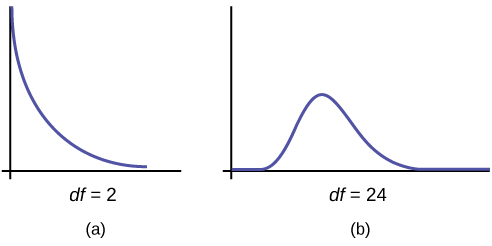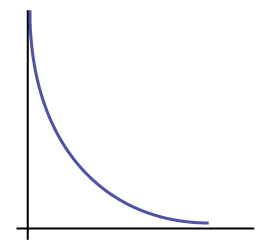| << Chapter < Page | Chapter >> Page > |
The notation for the chi-square distribution is:
where
df = degrees of freedom which depends on how chi-square is being used. (If you want to practice calculating chi-square probabilities then use
df =
n - 1. The degrees of freedom for the three major uses are each calculated differently.)
For the χ 2 distribution, the population mean is μ = df and the population standard deviation is .
The random variable is shown as χ 2 , but may be any upper case letter.
The random variable for a chi-square distribution with k degrees of freedom is the sum of k independent, squared standard normal variables.
χ 2 = ( Z 1 ) 2 + ( Z 2 ) 2 + ... + ( Z k ) 2


Data from Parade Magazine .
“HIV/AIDS Epidemiology Santa Clara County.”Santa Clara County Public Health Department, May 2011.
The chi-square distribution is a useful tool for assessment in a series of problem categories. These problem categories include primarily (i) whether a data set fits a particular distribution, (ii) whether the distributions of two populations are the same, (iii) whether two events might be independent, and (iv) whether there is a different variability than expected within a population.
An important parameter in a chi-square distribution is the degrees of freedom df in a given problem. The random variable in the chi-square distribution is the sum of squares of df standard normal variables, which must be independent. The key characteristics of the chi-square distribution also depend directly on the degrees of freedom.
The chi-square distribution curve is skewed to the right, and its shape depends on the degrees of freedom df . For df >90, the curve approximates the normal distribution. Test statistics based on the chi-square distribution are always greater than or equal to zero. Such application tests are almost always right-tailed tests.
χ 2 = ( Z 1 ) 2 + ( Z 2 ) 2 + … ( Z df ) 2 chi-square distribution random variable
μ χ 2 = df chi-square distribution population mean
Chi-Square distribution population standard deviation
If the number of degrees of freedom for a chi-square distribution is 25, what is the population mean and standard deviation?
mean = 25 and standard deviation = 7.0711
If df >90, the distribution is _____________. If df = 15, the distribution is ________________.
When does the chi-square curve approximate a normal distribution?
when the number of degrees of freedom is greater than 90
Where is μ located on a chi-square curve?
Is it more likely the df is 90, 20, or two in the graph?

df = 2

Notification Switch
Would you like to follow the 'Introductory statistics' conversation and receive update notifications?